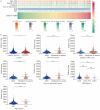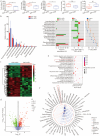High-salt-driven gut microbiota dysfunction aggravates prostatitis by promoting AHR/SGK1/FOXO1 axis-mediated Th17 cell differentiation
- PMID: 40383790
- PMCID: PMC12087074
- DOI: 10.1186/s40779-025-00607-1
High-salt-driven gut microbiota dysfunction aggravates prostatitis by promoting AHR/SGK1/FOXO1 axis-mediated Th17 cell differentiation
Abstract
Background: Chronic prostatitis/chronic pelvic pain syndrome (CP/CPPS) is a frequently encountered disorder characterized by voiding symptoms and pelvic or perineal pain. Proinflammatory T helper 17 (Th17) cells are essential for triggering the development of CP/CPPS. High-salt diet (HSD) consumption has been found to cause an accumulation of sodium chloride in peripheral organs, inducing autoimmune responses via the Th17 cell axis. It is currently unknown whether HSD affects the etiology and course of CP/CPPS.
Methods: Patients diagnosed with CP/CPPS were evaluated with the National Institutes of Health Chronic Prostatitis Symptom Index scoring system, and the correlation between the symptoms of CP/CPPS with HSD was analyzed. The experimental autoimmune prostatitis (EAP) mouse was established and the mice were fed either a normal-salt diet (NSD) or HSD for 6 weeks to investigate the impact of HSD on CP/CPPS. Then, 16S ribosomal RNA sequencing and untargeted metabolomics were introduced to detect the differences in the gut microflora composition and metabolite profiles between NSD-fed and HSD-fed mice, followed by fecal microbiota transplantation, 5-hydroxyindole acetic acid (5-HIAA) supplementation, aryl hydrocarbon receptor (AHR) inhibition, and in vitro Th17 differentiation experiments, which were performed to explore the mechanisms underlying HSD-aggravated CP/CPPS. Finally, chromatin immunoprecipitation assay and quantitative polymerase chain reaction were conducted to validate whether AHR can serve as a transcription factor by interacting with the serum and glucocorticoid-regulated kinase 1 (Sgk1) promoter in CD4+ T cells.
Results: Increased salt consumption had a positive correlation with symptom scores of CP/CPPS patients, which was validated by feeding EAP mice with HSD, and HSD worsened the prostate inflammation and tactile allodynia in EAP mice through promoting the differentiation of CD4+ T cells to Th17 cells. HSD exacerbated EAP by significantly reducing the relative abundance of beneficial gut microflora, such as Lactobacillaceae, and gut microbiota metabolite 5-HIAA, which is related to tryptophan metabolism. The prostate inflammation, tactile allodynia, and proportion of Th17 cells in mice that received fecal suspensions from the EAP + HSD group were significantly more severe or higher than those in mice that received fecal suspensions from the EAP + NSD group. However, 5-HIAA supplementation ameliorated the symptoms of EAP caused by HSD through inhibiting the differentiation of CD4+ T cells to Th17 cells, while AHR inhibition abrogated the protective effects of 5-HIAA supplementation on EAP mice fed a HSD through promoting the differentiation of CD4+ T cells to Th17 cells. Mechanistically, it has been revealed that the SGK1/forkhead box protein O1 (FOXO1) pathway was significantly activated during cytokine-induced Th17 cell differentiation, and AHR has been shown to inhibit SGK1 transcription by interacting with the Sgk1 promoter in CD4+ T cells to inhibit FOXO1 phosphorylation, consequently restoring the equilibrium of Th17 cell differentiation.
Conclusion: Our findings indicated that high salt intake represented a risk factor for the development of CP/CPPS as it promoted the differentiation of CD4+ T cells to Th17 cells through the 5-HIAA/AHR/SGK1/FOXO1 axis, which might be a potential therapeutic target for CP/CPPS.
Keywords: 5-Hydroxyindole acetic acid (5HIAA); Chronic prostatitis/chronic pelvic pain syndrome (CP/CPPS); High-salt diet; Serum and glucocorticoid-regulated kinase 1 (SGK1); Th17 cells.
© 2025. The Author(s).
Conflict of interest statement
Declarations. Ethics approval and consent to participate: The First Affiliated Hospital of Anhui Medical University’s Ethics Committee authorized a protocol for patient recruitment (PJ2024-03-37). All animal experiments were approved by the Animal Care and Use of the Animal Center of Anhui Medical University (LLSC20241761). Consent for publication: All authors have approved the submission of this manuscript to this journal. Competing interests: The authors declare that there is no conflict of interest.
Figures








Similar articles
-
Alcohol intake exacerbates experimental autoimmune prostatitis through gut microbiota driving cholesterol biosynthesis-mediated Th17 differentiation.Int Immunopharmacol. 2024 Sep 30;139:112669. doi: 10.1016/j.intimp.2024.112669. Epub 2024 Jul 18. Int Immunopharmacol. 2024. PMID: 39029231
-
Gut Microflora Modulates Th17/Treg Cell Differentiation in Experimental Autoimmune Prostatitis via the Short-Chain Fatty Acid Propionate.Front Immunol. 2022 Jul 4;13:915218. doi: 10.3389/fimmu.2022.915218. eCollection 2022. Front Immunol. 2022. PMID: 35860242 Free PMC article.
-
Astaxanthin alleviates chronic prostatitis/chronic pelvic pain syndrome by increasing colonization of Akkermansia muciniphila in the intestine.Phytomedicine. 2024 Jan;123:155249. doi: 10.1016/j.phymed.2023.155249. Epub 2023 Nov 25. Phytomedicine. 2024. PMID: 38056144
-
Experimental autoimmune prostatitis: different antigens induction and antigen-specific therapy.Int Urol Nephrol. 2021 Apr;53(4):607-618. doi: 10.1007/s11255-020-02703-8. Epub 2020 Nov 16. Int Urol Nephrol. 2021. PMID: 33200334 Review.
-
Immunological alterations in patients with chronic prostatitis/chronic pelvic pain syndrome and experimental autoimmune prostatitis model: A systematic review and meta-analysis.Cytokine. 2021 May;141:155440. doi: 10.1016/j.cyto.2021.155440. Epub 2021 Feb 4. Cytokine. 2021. PMID: 33550164
References
-
- Hochreiter WW, Z’brun S. Chronic pelvic pain syndrome and voiding dysfunction. Curr Urol Rep. 2004;5(4):300–4. - PubMed
-
- Khan FU, Ihsan AU, Khan HU, Jana R, Wazir J, Khongorzul P, et al. Comprehensive overview of prostatitis. Biomed Pharmacother. 2017;94:1064–76. - PubMed
-
- Chen J, Meng J, Jin C, Mo F, Ding Y, Gao X, et al. 4-Methylumbelliferone treatment and hyaluronan inhibition as a therapeutic strategy for chronic prostatitis. Prostate. 2021;81(14):1078–90. - PubMed
-
- Liu Y, Wazir J, Tang M, Ullah R, Chen Y, Chen T, et al. Experimental autoimmune prostatitis: different antigens induction and antigen-specific therapy. Int Urol Nephrol. 2021;53(4):607–18. - PubMed
MeSH terms
Substances
Grants and funding
- 82300872/National Natural Science Foundation of China
- 82170787/National Natural Science Foundation of China
- T000529/Supporting Projects for Innovative Leading Talents
- 2021-108-10/Distinguished Young Scholar of Anhui Colleges
- 2022AH020073/Science Foundation for Outstanding Young Scholar of Anhui Colleges
LinkOut - more resources
Full Text Sources
Research Materials
Miscellaneous

